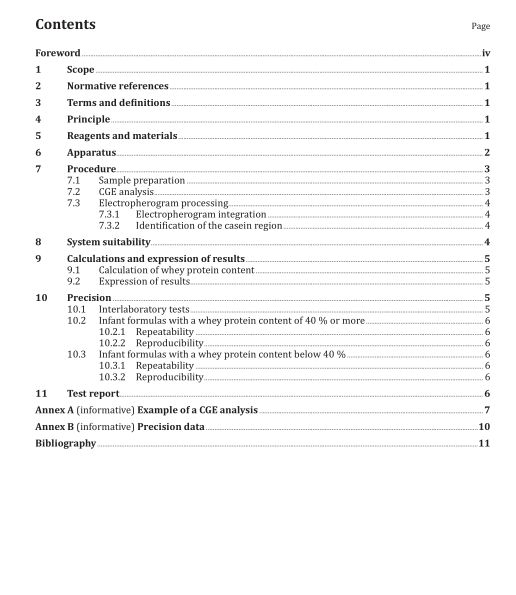ISO 23293:2020 pdf download.Milk-based infant formula powders — Quantification of whey protein content by sodium dodecyl sulfate-capillary gel electrophoresis (SDS-CGE)
This document specifies a method for the determination of the whey to casein protein ratio, ranging from 20:80 to 80:20 in cow milk-based infant formula powders.
This method does not apply to the analysis of infant formulas containing hydrolysed protein or proteins from other sources (e.g. plants or milk from other mammals).
2 Normative references
There are no normative references in this document.
3 Terms and definitions
For the purposes of this document, the following terms and definitions apply.
ISO and IEC maintain terminological databases for use in standardization at the following addresses:
— ISO Online browsing platform: available at https:// www .iso .org/ obp
— IEC Electropedia: available at http:// www .electropedia .org/
3.1 infant formula
breast-milk substitute specially manufactured to satisfy, by itself, the nutritional requirements of infants during the first months of life up to the introduction of appropriate complementary feeding [SOURCE: Codex Standard 72-1981]
4 Principle
In sodium dodecyl sulfate-capillary gel electrophoresis (SDS-CGE), proteins in infant formula samples are denatured by the anionic surfactant SDS and reduced by β-mercaptoethanol. The SDS-bonded,electrically charged proteins migrate in an electrical field filled with a separation gel and are detected by UV at 220 nm. Caseins and whey proteins are separated as two distinct, non-overlapping groups of peaks where the ratio can be established based on integrated areas without the need for a calibration curve. In the calculation of whey protein content, 1,4 was used as the mass-to-area correction factor for whey proteins versus caseins.
5 Reagents and materials
During the analysis, unless otherwise stated, use only reagents of recognized analytical grade and distilled or demineralized water or water of equivalent purity.
Data from the multi-laboratory study was obtained with chemicals from the SDS-MW kit 390953 from Beckman Coulter/Sciex 1) . The SDS-MW gel separation buffer recipe described below (5.1) was tested in a separate study and found to be equivalent to the commercial SDS-MW gel separation buffer included in the kit. One laboratory used home-made reagents (5.2 to 5.5). All laboratories used the 10 kDa internal protein standard (5.6) and the SDS-MW size standard (5.7) from the kit. Use of equivalent standards requires prior verification.
5.1 SDS-MW gel separation buffer, tris(hydroxymethyl)aminomethane (Tris), boric acid, SDS, EDTA,glycerol and dextran 2000 1) .
Dissolve 0,726 6 g Tris base and 0,371 0 g boric acid in 9 ml water. Add 20 mg SDS, 1 g dextran 2000, 14,6 mg EDTA, and 1 ml glycerol. Mix thoroughly. Leave overnight to allow complete dextran solubilization.
NOTE Dextran 2000 has an average molecular weight of 2 000 000 Da.
5.2 SDS-MW sample buffer, 100 mmol/l Tris, pH 9,0, 1 % SDS.
Dissolve 109,4 mg of Tris base, 15,2 mg of Tris hydrocholoride and 0,1 g of SDS in 10 ml water.
5.3 Acidic wash solution, hydrochloric acid, substance concentration c = 0,1 mol/l.
5.4 Basic wash solution, sodium hydroxide, c = 0,1 mol/l.
5.5 β-mercaptoethanol.
5.6 10 kDa internal protein standard, mass concentration ρ = 5 mg/ml.
5.7 SDS-MW size standard, 10 to 225 kDa, ρ = 16 mg/ml.
5.8 Sample running pre-solution.
Mix the SDS-MW sample buffer (5.2) with the 10 kDa internal protein standard (5.6) using an 84:1 ratio. Prepare a sufficient volume based on the total number of samples to be analysed in the sample set (90 μl of sample running pre-solution is needed per sample).
6 Apparatus
Usual laboratory glassware and equipment and, in particular, the following.
6.1 Capillary electrophoresis instrument, equipped with UV detector set at 220 nm and capable of maintaining the capillary and sample tray at 25 °C ± 2 °C.
Suitable software should be available for peak integration.
6.2 Bare, fused-silica capillaries, of 50 μm internal diameter × 30 cm, with effective length of 20 cm.
6.3 Temperature controlled water bath or heating block, capable of maintaining a temperature of 95 °C ± 5 °C.
6.4 Micro centrifuge, with adaptors for 1,5 ml centrifuge vials.
6.5 Vortex.
6.6 Adjustable pipettes and tips, volume of 20 μl, 100 μl and 1 000 μl.
6.7 Safe-lock micro-centrifuge vials, volume of 1,5 ml or 2,0 ml.
6.8 Round-bottom centrifuge tubes, volume of 10 ml.
6.9 Analytical balance, weighing to four decimal places.ISO 23293 pdf download.ISO 23293 pdf download
